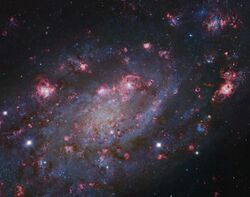Astronomy:NGC 2403
| NGC 2403 | |
|---|---|
 A Hubble Space Telescope (HST), and Subaru image of NGC 2403. NGC 2404 is visible | |
| Observation data (J2000 epoch) | |
| Constellation | Camelopardalis |
| Right ascension | 07h 36m 51.4s[1] |
| Declination | +65° 36′ 09″[1] |
| Redshift | 131 ± 3 km/s[1] |
| Apparent magnitude (V) | 8.9[1] |
| Characteristics | |
| Type | SAB(s)cd[1] |
| Apparent size (V) | 21.9′ × 12.3′[1] |
| Other designations | |
| UGC 3918,[1] PGC 21396,[1] Caldwell 7 | |
NGC 2403 (also known as Caldwell 7) is an intermediate spiral galaxy in the constellation Camelopardalis. It is an outlying member of the M81 Group,[2] and is approximately 8 million light-years distant. It bears a similarity to M33, being about 50,000 light years in diameter and containing numerous star-forming H II regions.[3] The northern spiral arm connects it to the star forming region NGC 2404.[2] NGC 2403 can be observed using 10×50 binoculars.[2] NGC 2404 is 940 light-years in diameter, making it one of the largest known H II regions. This H II region represents striking similarity with NGC 604 in M33, both in size and location in galaxy.
Supernovae
There have been two reported supernovae in the galaxy: SN 1954J, which attained a magnitude of 16 at its brightest, and SN 2004dj, which attained a magnitude of 11.2. SN 2004dj is the nearest and brightest supernova observed in the 21st century.
History
The galaxy was discovered by William Herschel in 1788. Edwin Hubble detected Cepheid variables in NGC 2403 using the Hale telescope, making it the first galaxy beyond the Local Group within which a Cepheid was discovered.[2] By 1963, 59 variables had been found in NGC 2403, of which 17 were eventually confirmed as Cepheids, with periods between 20 and 87 days. As late as 1950 Hubble was using a distance of just under 2 million light years for the galaxy's distance, but by 1968 the analysis of the Cepheids increased this by almost a factor of five, to within 0.2 magnitudes of the current value.
Companions
NGC 2403 has two known companions. One is the relatively massive dwarf galaxy DDO 44. It is currently being disrupted by NGC 2403, as evidenced by a tidal stream extending 82 kly (25 kpc) on both sides of DDO 44. DDO 44 is approaching NGC 2403 at a distance much closer than typical for dwarf galaxy interactions. It currently has a V-band absolute magnitude of −12.9, but its progenitor was even more luminous.[4]
The other known companion is officially named MADCASH J074238+652501-dw, although it is nicknamed MADCASH-1. The name refers to the MADCASH (Magellanic Analog Dwarf Companions and Stellar Halos) project. MADCASH-1 is similar to typical dwarf spheroidal galaxies in the Local Group; it is quite faint, with an absolute V-band magnitude of −7.81, and has only an ancient, metal-poor population of red giant stars.[5]
See also
- Triangulum Galaxy-looks very similar to NGC 2403.
References
- ↑ 1.0 1.1 1.2 1.3 1.4 1.5 1.6 1.7 "NASA/IPAC Extragalactic Database". Results for NGC 2403. http://nedwww.ipac.caltech.edu/.
- ↑ 2.0 2.1 2.2 2.3 Kepple, George Robert; Glen W. Sanner (1998). The Night Sky Observer's Guide. 1. Willmann-Bell, Inc.. p. 73. ISBN 978-0-943396-58-3.
- ↑ Ho, Luis C.; Filippenko, Alexei V.; Sargent, Wallace L. W. (October 1997). "A Search for "Dwarf" Seyfert Nuclei. III. Spectroscopic Parameters and Properties of the Host Galaxies". Astrophysical Journal Supplement 112 (2): 315–390. doi:10.1086/313041. Bibcode: 1997ApJS..112..315H.
- ↑ Cite error: Invalid
<ref>tag; no text was provided for refs namedjeffrey - ↑ Carlin, Jeffrey L.; Mutlu-Pakdil, Burçin; Crnojević, Denija; Garling, Christopher T.; Karunakaran, Ananthan; Peter, Annika H. G.; Tollerud, Erik; Forbes, Duncan A. et al. (2021). "Hubble Space Telescope Observations of Two Faint Dwarf Satellites of Nearby LMC Analogs from MADCASH". The Astrophysical Journal 909 (2): 211. doi:10.3847/1538-4357/abe040. Bibcode: 2021ApJ...909..211C.
External links
| Wikimedia Commons has media related to NGC 2403. |
- Spiral Galaxy NGC 2403 at the astro-photography site of Mr. Takayuki Yoshida
- NGC 2403 at ESA/Hubble
- NGC 2403 on WikiSky: DSS2, SDSS, GALEX, IRAS, Hydrogen α, X-Ray, Astrophoto, Sky Map, Articles and images
- NASA Astronomy Picture of the Day: NGC 2403 (19 February 2016)
- SEDS – NGC 2403
Coordinates: ![]() 07h 36m 51.4s, +65° 36′ 09″
07h 36m 51.4s, +65° 36′ 09″
 |


